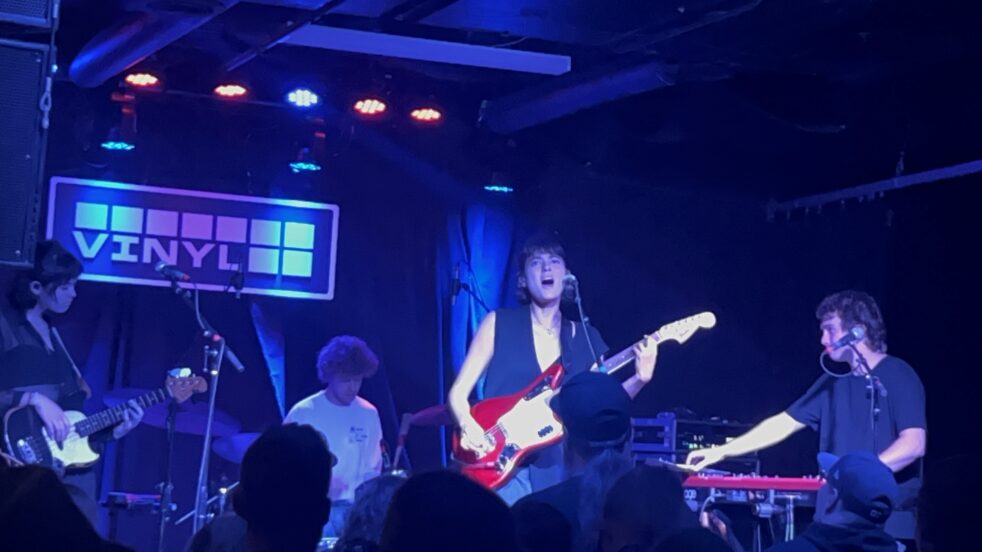Miya Folick hosted an intimate performance at the Vinyl in celebration of the release of her new album “ROACH.” Folick is a Los Angeles-based singer-songwriter whose music leans primarily towards indie rock.
“ROACH” is Folick’s first full-length album since the release of her 2018 debut album “Premonitions.” Folick’s new album follows her experience as she attempts to move past prior bad habits and destructive relationships on the path toward defining herself and her needs.
Atlanta-based singer Babebee was originally scheduled to open for Folick, but due to vocal troubles, she was unable to perform. Since this only became known shortly before the show was supposed to start, Folick and her band had to come up with a quick solution over who would be the alternative opening act. Folick introduced two of her own band members, Jacob Ungerleider and Maia Nelson, who each performed several of their own songs before finally turning the stage over to Folick to begin her performance.
Cast in blue light, Folick sang songs including “Nothing to See,” “Bad Thing,” “Cockroach” and “Get Out of My House,” as well as a couple of unreleased songs. While performing “Nothing to See,” Folick donned an electric guitar and joined her band in playing the background score as she sang.
She closed her eyes and furrowed her brows as she immersed herself in the story, and the pitch of her voice rose to what seemed like an emotional breaking point as she recited the lines, “Said I would never be desperate/Look at me/Why did I do that?” Folick’s pitch rose during lyrics that emphasized her desperation, then fell for the corresponding reflective lyrics.
The natural roughness of Folick’s voice paired with her choice to lower her pitch throughout a line added to the emotional and raw feeling of her performance. Folick also let her voice trail off at the end of “Nothing to see,” emphasizing the resignation she feels towards the relationship the song describes.
The addition of a live band was indispensable to Folick’s performance. Guitar strumming blended with
Folick’s voice and added an element of rawness that would not have been possible with pre-recorded and perfected background music, like those common in many live concerts today.
The live band also allowed the song and venue to take on a more dynamic feel — the beat drop and sudden introduction of drums between “There’s nothing to see here” and “There’s nothing to see” in the song “Nothing to See” were prime examples.
During this specific instance, Folick paused her singing, and her and her bandmates looked down, intently focusing on their respective instruments, bobbing their heads to the beat.
During Folick’s performance of “Bad Thing,” her bandmate switched from electric guitar to keyboard, adding background synths that gave an almost dreamy mood to the song.
The raspiness of Folick’s voice contrasted with the smooth, higher-pitched synth waves, but they managed to combine as Folick eased through the lyrics, and the synth periods stretched to match the beat. Together, they created an environment that encouraged the audience to sway along to the music and feel the imperfections of Folick’s voice and the person she narrates.
While introducing the song “Tetherball,” Folick described the writing process of the song as being very quick — happening in less than one day. She said that “Tetherball” included some of her favorite lyrics within her music since the song “really described how [she] was feeling at the time so well. [She] was moving so fast but
going nowhere.”
Folick gave a strained laugh as she described herself at the time, saying that the faster she was moving, the more she became tangled up and the “closer [she got] to being trapped.”
She ultimately reflected on her feelings at the time, connecting the trapped feelings she encountered in her relationships back to herself and realizing that it was “[her], and what [she] was doing that made her feel that way.”
In her performance of “Cartoon Clouds,” Folick once again utilized sudden jumps in pitch to emphasize the desperation of the narrator. In contrast to how she sang “Nothing to See,” the sudden jumps in pitch occurred at the ends of lines instead of at the beginning and then trailed off like in “Nothing to See.”
Folick also used synth in this song, which acted like beams of light poking through into a cloudy song, brightening it while still preserving its gentle nature.
In between songs, Folick commented briefly on the nature of clowns, saying that the reason clowns are so fun to watch is because it is just people “being pure emotion and taking away the facade … being pure instinct.” After realizing that she had gotten a little sidetracked, Folick jokingly said that “this concludes the clowning
portion of the set.”
The remaining songs of the set were overall more upbeat featuring a currently unreleased song titled “Mid July” that Folick stated was about falling in love. Folick also performed “Get Out of My House” off of “ROACH” where she embraced the rougher aspects of her voice in a performance that leaned heavily towards rock rather than indie rock like most of her music.
Folick announced on her Instagram @miyafolick on Oct. 17, 2023 that she would be joining Mitski on Mitski’s upcoming “The Land Is Inhospitable and So Are We” album tour. Folick will be opening for Mitski in five different shows in the United Kingdom.
